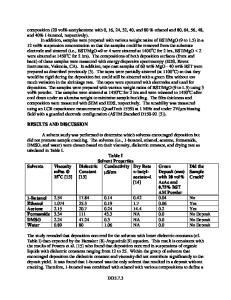Functionally Graded Al Alloy Matrix In-Situ Composites
- PDF / 1,172,640 Bytes
- 13 Pages / 593.972 x 792 pts Page_size
- 71 Downloads / 437 Views
INTRODUCTION
FUNCTIONALLY graded (FG) materials are a new class of advanced structural materials in which the composition and the microstructure are intentionally varied from one end to the other end based on the applications.[1] These materials have wider applications in many automotive and structural components, such as brake rotor discs, cylinder liners, pulleys, rocket nozzles, computer circuit boards, medical implants, armors, and optical devices.[2] There are many processing routes to synthesize FG materials such as plasma spraying, spray forming, chemical vapor deposition, physical vapor deposition, sol-gel, molten metal infiltration, adhesive bonding, self-propagating high-temperature synthesis, and centrifugal casting. Nai et al.[3] categorized the processing techniques for the synthesis of FG materials into three groups: solid phase techniques, liquid phase techniques, and vapor phase techniques. Other than centrifugal casting techniques, all other routes suffer from several limitations, such as (1) delamination of the coatings due to high thermal stress and wear; (2) reduced life time of the coatings due to deleterious effects such as high-temperature oxidation, evaporation, melting, crystallization, gas release, and other processing problems; (c) difficulties in producing coatings of continuous quality; and (d) limited thickness of the S. KUMAR, formerly Doctoral Student, Department of Metallurgical and Materials Engineering, Indian Institute of Technology Madras, Chennai 600 036, India, is Research Fellow, Brunel Centre for Advanced Solidification Technology (BCAST), Brunel University, West London, UB8 3PH, United Kingdom. V. SUBRAMANIYA SARMA, Assistant Professor, and B.S. MURTY, Professor, are with the Department of Metallurgical and Materials Engineering, Indian Institute of Technology Madras. Contact e-mail: [email protected] Manuscript submitted June 3, 2009. Article published online October 27, 2009 242—VOLUME 41A, JANUARY 2010
coatings. Among these processing techniques, centrifugal casting is a simple and an economical method to produce large-scale FG components. The microstructure and composition of the FG materials can be easily controlled in the centrifugal casting method. However, centrifugal casting can only be used for producing axisymmetric components. Among various FG materials, functionally graded– metal matrix composites (FG-MMCs) are of great interest because of the excellent performance of the composites in aggressive environments.[4] Aluminumbased MMCs with particulate reinforcement give superior properties such as improved strength, specific modulus, thermal stability, and wear resistance when compared to the matrix alloy. It is also well established that an increase in volume fraction of the reinforcement increases the performance of the composites. The main drawback of the MMCs is the high cost factor involved in the synthesis. The cost can be significantly reduced (by ~30 pct) through replacement of the bulk MMCs by MMC coatings or claddings.[5] This type of Al-based MMC coatings or cla
Data Loading...











